This was published 5 years ago
Bali's Mulia Resort: More than 1500 guests - what it's like staying at Bali's biggest resort
By Max Anderson
Mulia Bali is the biggest resort in Bali, accommodating more than 1500 guests. It's also among the most expensive, with a minimum nightly tariff of $630 after taxes, a price which feels rather more Bermuda than Bali.
Big isn't always beautiful, especially in the world of luxury resorts where designers are apt to trowel on the bling like Monty Python's Mr Creosote shovels in the food. Moreover, as the passengers of the Titanic might have attested, "big and expensive" doesn't always guarantee a great holiday.
Nevertheless, since opening in 2012, Mulia Bali has been consistently rated by readers of US magazines (including Forbes and Condé Nast Traveler) as among the world's best beach resorts.
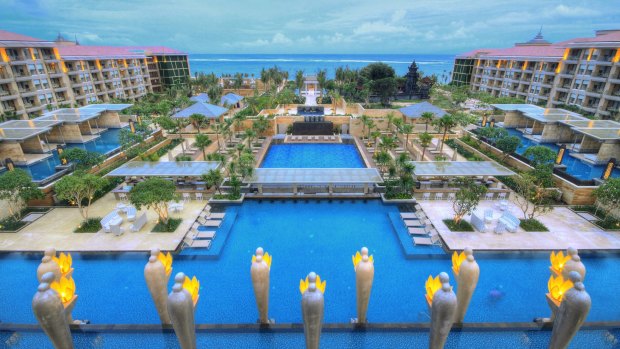
Bali's biggest resort, Mulia.
So here's the question: is it any good?
Having arrived in the middle of the night, I get to enjoy a spectacular "reveal" when I throw back the heavy drapes on my huge fourth-floor suite. I'm looking at the calm reef waters of Nusa Dua glowing suitably turquoise against the coarse yellow sands. Off to the right is a prominent limestone headland with a sweet Balinese temple in silhouette.
Immediately beneath my balcony – and in contrast to the little temple – is a swimming pool attended by 16 five-metre female figures arranged in two lines. This honour guard of statues begins in the pool and ends out on the beach. It's a brazen statement and my first instincts are to deride the view as a sort of Vegas-on-sea.
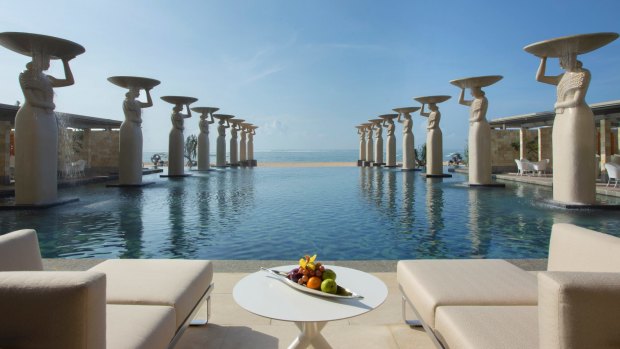
The Mulia Mulia Bali swimming pool is attended by 16 five-metre female figures.
Yet the sculptures are simple and serene, and the proportions are absolutely right. And in fairness, this is Nusa Dua, an unapologetic five-star resort strip purpose built in the 1970s for people who want bedazzlement as much as they want Bali.
My suite makes a similarly big statement befitting its price tag ($1600 plus 20 per cent tax). It's elegant, in fawns and beiges and metallics, plushly upholstered and hung with unusually cool pan-Asian art. There's a spa bath on the 20 square metre balcony, the bed is dressed in Egyptian cotton and the toilet salutes me every time I approach by lifting its own lid. The butler for the 4th floor, Yogi, is equally attentive. He volunteers to reserve a poolside cabana so I can read my international edition of The New York Times, and ensures I'm furnished with a plate of fruit, a bottle of water and a sunglasses-cleaning service. And he makes certain I never wait more than a second or two for a golf buggy to shuttle me to different corners of the resort.
Buggies are essential in Mulia Bali because it's spread over 30 hectares sloping upwards from the beach. If the scale sounds a trifle wearying, it's also a key to one of the resort's strengths. The property is actually three resorts in one, reflected in its ungainly and rarely-if-ever used official name The Mulia, Mulia Resort and Villas.
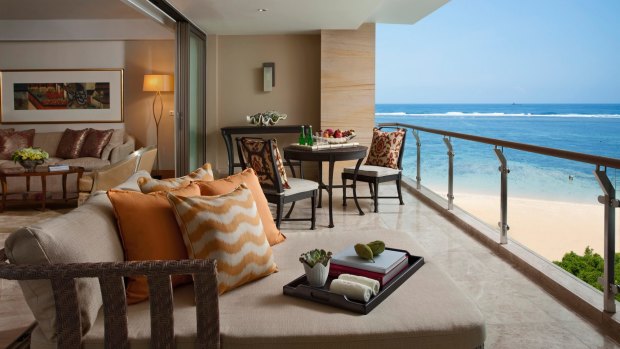
A pleasant spot for a rest at the Mulia Bali.
At the heart of the resort is the family-friendly, entry-level Mulia Resort. It incorporates 526 suites, four restaurants, two bars, a multitude of swimming pools, a creche, a large gym, an even larger nightclub and a deli selling the most delicate and decadent cakes you've ever seen.
Next is The Mulia, the exclusive beach-front wing with 111 suites, complete with its private pool flanked by the aforementioned honour guard of giant ladies.
Finally on the resort's upper slopes, among the breezes and the dragonflies, there's the equally exclusive Mulia Villas – a gated community of 108 balmy Asian bungalows. These have private garden pools and signature round bathtubs that butlers will sprinkle with rose petals and arrange to be lusciously bubbled.
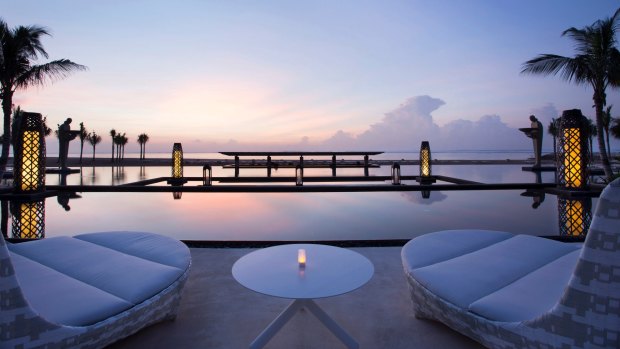
Sunset over Mulia, Bali.
The two exclusive sections are priced similarly – starting north of around $1000 a night – and favoured by stars such as Fergie, Christina Ricci and Millie Bobby Brown. Both have dedicated dining areas, but guests can, of course, go to the larger Resort complex to avail themselves of the wider facilities.
While that's a one-way privilege, anyone can enjoy the three things that make Mulia Bali a standout. First, you get service that is very good indeed, provided by 2000 staff working on any given day. Out of the 10 staff I speak with, six have been with the resort for four years, a good sign in anybody's book. The butlers are internationally trained, and it shows.
Second, guests enjoy aesthetics that are bold and frequently beautiful. The entrance has a whimsical quadrangle lined with giant rose blooms cast in resin, each flower a metre wide. There are spectacular "dragon's tail" light installations in the main resort which is cleaned yearly by a glass expert shipped in from Italy. And a floating glass chapel sits in a one-acre lake – which is actually a shallow tiled pool – created solely so wedding parties can be bathed in its sapphire hues.
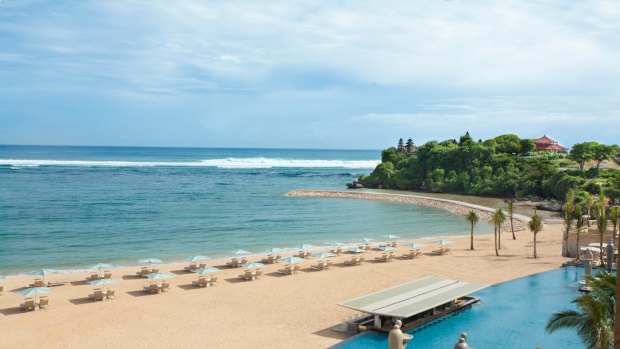
Mulia's beachfront.
The main Resort is as lush as it is large, fusing shade, gardens and sunken pools and effectively diminishing the huge guest count by creating spaces that feel secluded and exclusive. The decor resists the temptation to do Bali-by-the-yard, choosing instead to blend ancient and modern aesthetics from across Asia. It's lively, often humorous and much of it has been mimeographed from the Indonesian owner's private collection.
Thirdly, and finally, guests at Mulia Bali are in store for a big surprise: regardless of where you are within the sprawling estate the standard of food is truly exceptional.
Table8 (Cantonese and Szechuan) Edogin (Teppanyaki), Soleil (Mediterranean and Pan-Asian) and The Cafe (international) are all buffet fare. But banish any thoughts of bain-marie free-for-alls. The restaurants comprise multiple serving stations, helmed by capable experts in their different cuisines – experts who will cheerfully share that the tempura zucchini flowers are grown on the north of the island, suggest ingredients to your taste before preparing a sensational Szechuan hotpot, and take a colourful turn with the spatulas to make an ice-cream teppanyaki directed by your choice of sweet inclusions.
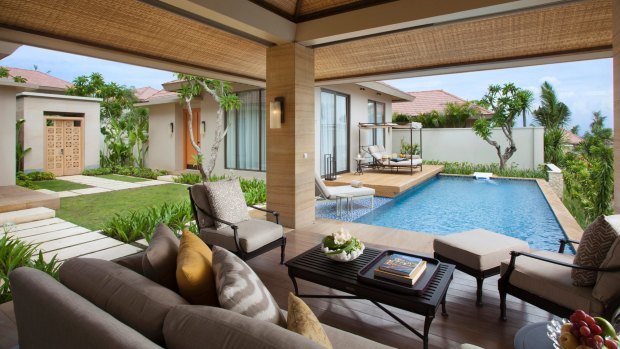
Private pool villa at Mulia.
The Sunday brunch at Soleil is famous on Bali. Well-heeled brunchers come from all over for a $90 splurge with unlimited drinks. It's one of Mulia Bali's best value propositions and offers a beautiful spread in cool boho/rococo surrounds. The cheese table, piled with international and Balinese produce, is as much a joy to look at as it is to plunder.
Constantly expecting the food standard to fail, I test what looks like a faintly ridiculous breakfast menu option. Sure enough, my Australian Black Angus tenderloin with baked egg in a brioche cup topped with melting duck liver is ridiculous – ridiculously good. The day when I'm treated again to steak with melting duck liver and gooey egg yolk cannot come soon enough.
All luxury resorts have their First-World-lunacy offerings and Mulia Bali is no different. Within the Villas is a $US20,000-minimum per night presidential suite: it's so exclusive you can't actually book it unless you're a CEO, oil sheik or, indeed, the Indonesian president. It measures a colossal 3300 square metres or 15 times the average Aussie family home.
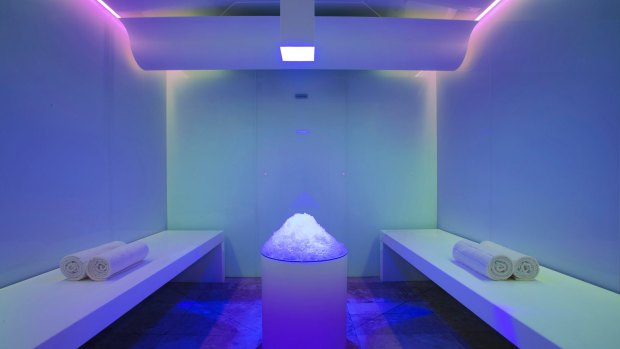
The spa at Mulia, Bali.
The Mulia Spa offers a trio of sauna treatments which takes you from a 45-degree dry heat room to an 80-degree wet steam room to a room that drops "oxygenic ice" from the ceiling – the first in the Asia-Pacific region. (This incidentally, is part of my four-hour spa treatment which racks up an eye-watering $850 bill.)
So, once again: is it any good?
Yes, in spite of its size, Mulia Bali is a very, very good resort. It caters expertly to the demands and expectations of an international clientele which will pay $650-$1600 a night for a suite (and even $850 for a four-hour spa treatment).
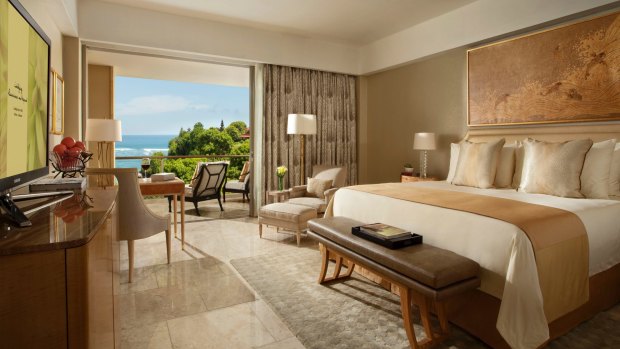
A room with balcony at Mulia, Bali.
But I can't help feeling some Australians will find it harder to square paying Park Hyatt Sydney prices at a destination that traditionally offers strong value. And if you're one of those Australians, I may have some good news. A colleague encountered an Aussie couple who'd secured a water view suite in the exclusive beachfront wing I was occupying. They said they got ocean views, as well as breakfast and dinner provided, and paid a price that was well below half the rack rate. The deal was secured via an online last-minute site.
I asked the hotel's communications director about this and she was unabashed that the Australian market gets offered a lot of good pricing, including last-minute deals. Basically, she said Australian travellers are a big market for Balinese resorts and owing to their proximity can fill space quickly.
Big, it seems, really can be better.
BIG BUSINESS ON BUKIT PENINSULA
Still with big things, if you're on a daytime flight into Denpasar, keep an eye out for the huge statue of part-human part-eagle creature Garuda being ridden by Vishnu, rising from southern Bali's Bukit Peninsula. You won't have to look too hard: at 120 metres, it's the world's third-tallest sculpture and a full third taller than Madame Liberty in New York.
The Garuda Wisnu Kencana Cultural Park (or GWK) was opened in September, 29 years after it was first mooted. The sculpture sits in the middle of a 60-hectare park and was born of the Hindu epic narrative Mahabharata.
It comprises 754 copper panels affixed to a stainless steel skeleton and weighs 4000 tonnes. While the height is impressive, it's the bulk of the statue that overwhelms. Indeed, it's so big (Garuda's wingspan is 64 metres) that it almost distorts the light, affecting a curious gauzy haze.
The park is a work in progress but it has regular cultural performances, shops, restaurants and even a clutch of huge Garuda eggs. To arrive at the foot of the sculpture you may find yourself negotiating a strange, slightly other-worldly quarried area called Tirtha Agung. The designers have dug deep into the limestone to leave a complex of corridors passing through apartment-sized blocks, with each block crowned by original vegetation. It's like you're in a primeval downtown, and as you wander through, you're constantly afforded views of the giant gods on their plinth.
Eventually, the sculpture's interior will open and the public will be able to access a platform installed in the golden crown of Vishnu. As the site's elevation is some 350 metres above sea level, the views should be spectacular. See gwkbali.com
TRIP NOTES
Max Anderson was a guest of the Mulia Bali.
MORE
FLY
Jetstar, Qantas and Virgin Australia fly regularly to Bali from Melbourne and Sydney. See jetstar.com.au ; qantas.com.au ; virginaustralia.com
STAY
Mulia Resort rooms start from $US380, plus 20 per cent tax, a night. The resort is a 40-minute taxi ride from the airport. themulia.com
See also: 20 things that will surprise first-time visitors to Bali
Sign up for the Traveller Deals newsletter
Get exclusive travel deals delivered straight to your inbox. Sign up now.